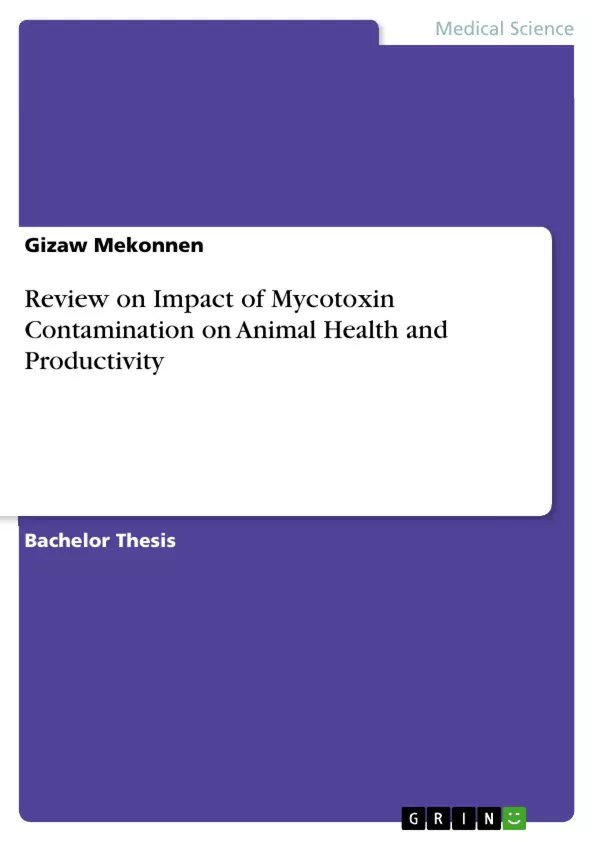Mycotoxins are secondary metabolism of filamentous fungi, which under suitable temperature and humidity conditions, and found in various foods and feeds, causing negative effect for human and animal health.There are different mycotoxins which have agricultural and economic importance including aflatoxins, ochratoxins, trichothecenes, zearalenone, fumonisins, tremorgenic toxins, and ergot alkaloids. Mycotoxins occur more frequently in areas with a hot and humid climate, favourable for the growth of molds, they can also be found in temperate zones.In comparison to monogastric species, ruminant animals are generally less susceptible to the adverse effects caused by contamination of feeds with mycotoxins because presence of rumen microflora in rumen. However, a number of mycotoxins resist rumen degradation, causing distinct clinical signs of intoxication. Dairy cattle can be exposed to different number of mycotoxins because complex feeding diet originating from different feed materials such as roughage and concentrates. Exposure of diary catte to these mycotoxins may result in unexpected health problem. Due to apre-existing negative energy balance, cows in the transition period are considered to be particularly sensitive to the exposure to feeds. The variation of mycotoxinoccurence due to different factors, including agricultural practices and climatic conditions. Aflatoxins (AFs) are found in maize and peanuts, aswell as in tree nuts and dried fruits. OTA is found mainly in cereals, but significant levels of contamination may also occur in wine, coffee, spices and dried fruits. Other products of concern are beans, roasted coffee and cocoa, malt and beer, bread and bakery products, wines and grape juices, spices, poultry meat and kidneys, pig kidneys and pork sausages. The production of secondary metabolism is the effect of Fungal metabolism Secondary metabolites, are formed from a relatively small number of branch points of primary metabolic pathways. Among them some of these secondary metabolites are used as antibiotics, while others are very toxic and carcinogenic to humans and animals.Economic impact associated with mycotoxicosisincluding:Slower growth rates, Poor conception rates, inconsistentmanure, Increased disease susceptibility, Reduced production performance, loss of animal and human life, veterinary and public cost of treatment.
Inhaltsverzeichnis (Table of Contents)
- ACKNOWLEDGEMENTS
- LIST OF TABLES
- LIST OF FIGURES
- LIST OF ABBREVIATION
- SUMMARY
- 1. INTRODUCTION
- 2. LITERATURE REVIEW
- 2.1. occurrence and signifinance of mycotoxins..
- 2.2. Aflatoxin
- 2.3. Ochratoxin...
- 2.4. Zearalenone.
- 3. NEGATIVE EFFECTS OF MYCOTOXINS ON NON- RUMINANTS..
- 3.1 Poultry
- 3.2. Pigs
- 3.3. Horses
- 4. NEGATIVE EFFECTS OF MYCOTOXINS ON RUMINANTS.
- 4.1. Cattle..
- 4.2. Sheep...
- 4.3. Other Ruminants
- 5. METABOLISM OF MYCOTOXINS
- 6. ECONOMIC IMPACT OF MYCOTOXINS
- 7. CONCLUSION AND RECOMMENDATION.
- 8. REFERENCES
Zielsetzung und Themenschwerpunkte (Objectives and Key Themes)
This seminar paper aims to provide a comprehensive review of the impact of mycotoxin contamination on animal health and productivity. It explores the occurrence, significance, and negative effects of mycotoxins on both non-ruminants and ruminants. Additionally, the paper examines the metabolism of mycotoxins and their economic implications.
- Occurrence and significance of mycotoxins
- Impact of mycotoxins on animal health and productivity
- Economic implications of mycotoxin contamination
- Metabolism of mycotoxins
- Control measures and mitigation strategies
Zusammenfassung der Kapitel (Chapter Summaries)
The paper starts by introducing the topic of mycotoxins and their significance in animal health. It then delves into a comprehensive literature review, discussing the occurrence and significance of mycotoxins, focusing on specific toxins like aflatoxin, ochratoxin, and zearalenone. The paper further examines the negative effects of mycotoxins on different animal species, including poultry, pigs, horses, cattle, sheep, and other ruminants. It also explores the metabolism of mycotoxins and their economic impact. The conclusion summarizes the main findings and provides recommendations for mitigating the risks of mycotoxin contamination.
Schlüsselwörter (Keywords)
Mycotoxins, animal health, productivity, contamination, aflatoxin, ochratoxin, zearalenone, poultry, pigs, horses, cattle, sheep, ruminants, metabolism, economic impact, control measures, mitigation strategies.
- Quote paper
- Gizaw Mekonnen (Author), 2019, Review on Impact of Mycotoxin Contamination on Animal Health and Productivity, Munich, GRIN Verlag, https://www.grin.com/document/512610



